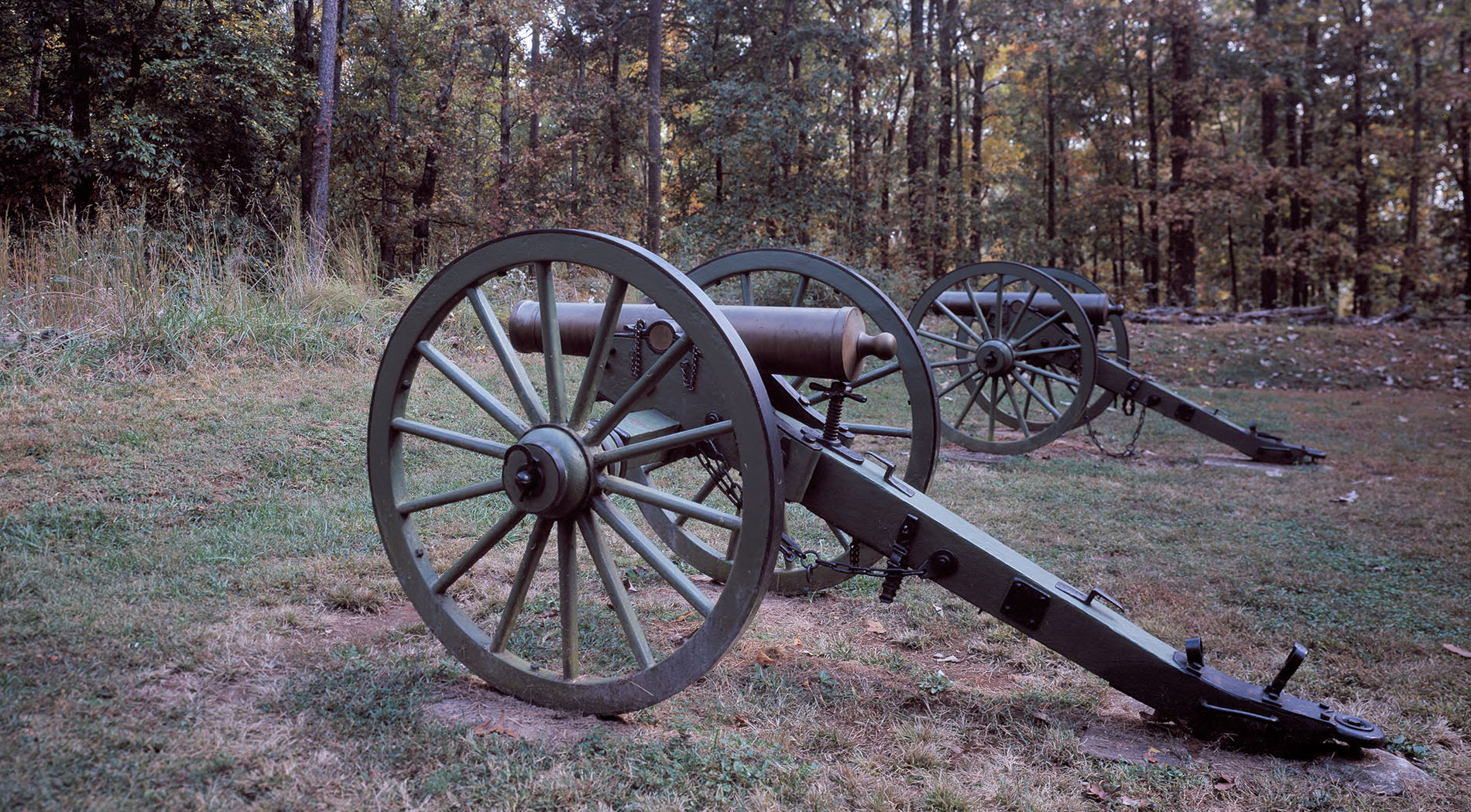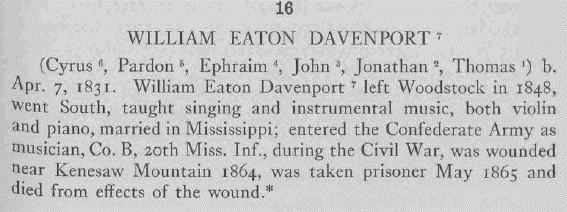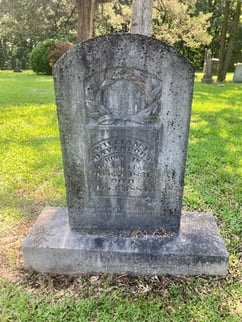
Cannons at Cheatham Hill, Kennesaw Mountain battle site, Georgia
Several lineage societies exist related to service in the American Civil War. These are, as you might imagine, divided by side—some relate to descendants of Union soldiers, others Confederate. Some men who belong to lineage societies for both sides call themselves “Sons of Both,” or “SOBs.”
For myself, I have two great-great-grandfathers who served in the Civil War, both for the Union: Josiah Steward Challender (1841-1896) from New Jersey, and James Stephenson Horton (1842-1924) from Ohio. Although one eighth of my ancestors lived in Virginia in the eighteenth and early nineteenth centuries, by the time of the Civil War those families had all moved to the northern states of Ohio and Indiana. In 1861 my direct ancestors were living in Connecticut, Massachusetts, Pennsylvania, Maryland, New Jersey, Maine, New York, Ohio, and Indiana.
A colleague asked me if I could identify my closest relative who served in the Confederacy. I assumed this would likely be a cousin from my mother’s Virginia ancestors—but finding a first cousin seemed unlikely, as my ancestral families largely left the South together with their siblings and extended family members. The closest maternal Confederate relative I found was Christopher Columbus Blankenbaker (1840-1913) of Missouri, who served as a private int the 10th Regiment, Missouri Cavalry. Christopher was second cousin to my matrilineal great-great-grandmother.
More recently, my aunt had asked me a question about our several-times great aunt – Tryphosa (Kendall) Davenport (1803-1877) of Woodstock, Connecticut. Tryphosa was the twin sister of my ancestor Tryphena (Kendall) Lyon, and the third of four sets of twins in that part of my family over the course of five generations. The summary of Tryphosa’s family in Clarence Winthrop Bowen’s Genealogies of Woodstock Families noted that four of her five sons served in the Civil War (her fifth son was born in 1848 and thus too young to serve). However, I was surprised to see that the service of Tryphosa’s second son William Eaton Davenport was not for the Union, but the Confederacy:

William Eaton Davenport was first cousin to my great-great-great-grandmother, so as it turns out, my closest Confederate relative is actually through my father’s New England ancestors. I was interested to see if William fought at any of the same battles as his brothers in the Union army. From Civil War Soldier Records and Profiles, service records, and regimental histories, I developed the following summary of each brother:
Cyrus Colden Davenport (1829-1906)
Company G, 18th Connecticut Regiment
- Enlisted 8 August 1862
- Mustered 21 August 1862, at Second Battle of Winchester
- Mustered out 27 January 1864
- Discharged due to disability 27 January 18641
William Eaton Davenport (1831-1884)
Company B, 20th Regiment, Mississippi Infantry, Musician
- Mustered into service 31 May 1861 at Battles of Fort Donelson, Fort Pemberton, Vicksburg, Champion Hill, Jackson, Meridian, New Hope Church, and Kennesaw Mountain
- Severely wounded at Battle of Kennesaw Mountain on 1 July 1864
Henry Pardon Davenport (1840-1862)
Company I, 7th Massachusetts Infantry
- Enlisted and mustered 15 June 1861
- Caught measles at Arlington, Virginia
- Died at Camp Brightwood, District of Columbia, 22 February 1862
Charles Edward Davenport (1843-1868)
Company F, 11th Connecticut Infantry
- Enlisted 14 October 1861
- Mustered 12 November 1861
- Caught measles at the State Camp in Hartford
- Joined Burnside’s expedition to Hatteras Inlet and Roanoke Island, North Carolina
- Fought at Battles of Roanoke Island and Newberne
- Had typhoid fever and was in a hospital at Hatteras for several months
- Mustered out 3 June 1862 due to disability and “came home a physical wreck”
In short, none of the brothers were in the same battles. Even the three who served for the Union all served in different regiments, and never shared a battlefield. My research into this question, however, had now raised a different conundrum: what happened to the Confederate Davenport brother, William Eaton?
According to Bowen’s Genealogies of Woodstock Families, William “was wounded near Kenesaw [sic] Mountain 1864, was taken prisoner May 1865 and died from effects of the wound” citing “Henry H. Davenport, Palm Holm Bellair, Fla.; Adjutant General’s Records, Washington, D.C.” The cited Henry Haskell Davenport (1859-1940) was William’s nephew, but I have not yet been able to locate the second record listed (I could not locate it in the related database on Ancestry).
However, the service record I compiled on William contradicts Bowen’s story. According to my research, William was severely wounded on 1 July 1864, sent to the hospital the same day, and put on wounded furlough for 60 days (until 26 September 1864). He then received payment for six months of service on 12 September 1864 at Demopolis, Alabama.
 Further, I found that William did not die immediately from his injuries, and in fact lived for nearly twenty years after he was wounded. He returned to Palmetto, Lee County, Mississippi, where he married and had four children, none of whom reached adulthood. William’s gravestone notes that he was “Born in Woodstock Co. Con Apr. 7, 1831. Died Oct. 13, 1884.” I chuckled at the town of Woodstock being referred to as a county—perhaps inscribed this way because of the importance of counties in the south, compared to their relative meaninglessness in Connecticut.
Further, I found that William did not die immediately from his injuries, and in fact lived for nearly twenty years after he was wounded. He returned to Palmetto, Lee County, Mississippi, where he married and had four children, none of whom reached adulthood. William’s gravestone notes that he was “Born in Woodstock Co. Con Apr. 7, 1831. Died Oct. 13, 1884.” I chuckled at the town of Woodstock being referred to as a county—perhaps inscribed this way because of the importance of counties in the south, compared to their relative meaninglessness in Connecticut.
Was William Eaton Davenport ever taken prisoner? Did he in fact die from effects of his wound, twenty years after the fact? Or could this have been his family’s way of saying that the Connecticut-born Confederate soldier from Mississippi was “dead” to his relatives up north? The full story of this Davenport family drama is most likely lost to history.
Learn More
External Database: American History from AM Explorer
Available to members of American Ancestors, the American History database from AM Explorer documents American History from the earliest settlers to the mid-twentieth century. This database includes a collection of around 20,000 letters, diaries and documents of Civil War participants on both sides of the conflict.
Free Video: Researching Black Soldiers in the Civil War
By the conclusion of the American Civil War, an estimated 179,000 Black men had served in the U.S. Army and another 19,000 in the Navy. In this lecture, researcher Jonathan Hill provides an overview of the records and tools that can be used to uncover the stories of Black Civil War veterans, including Compiled Military Service Records, Muster Rolls, Descriptive Rolls, Widows Pensions, Regimental Histories, Disability Certificates, and the 1890 Veterans Census, as well as primary source documentation such as newspapers and after action reports.
Stories from the Archives: Civil War Manuscripts
This lecture features items from the time of the Civil War found in the R. Stanton Avery Special Collections and the Wyner Family Jewish Heritage Center at NEHGS, including family correspondence, photos, diaries, and more. These archival collections represent both the Union and Confederacy sides, the concurrent slave trade, contemporary women’s voices, and the following era of Reconstruction.
Notes
[1] The Ancestry summary of Cyrus notes that he was “dishonorably Discharged.” (also stated on Fold3) However the source of this entry, Record of Service of Connecticut Men in the Army and Navy of the United States During the War of the Rebellion, 681, says he was “Disc.[discharged] dis.[disability] Jan. 27 ‘64”
Share this:
About Christopher C. Child
Chris Child has worked for various departments at NEHGS since 1997 and became a full-time employee in July 2003. He has been a member of NEHGS since the age of eleven. He has written several articles in American Ancestors, The New England Historical and Genealogical Register, and The Mayflower Descendant. He is the co-editor of The Ancestry of Catherine Middleton (NEHGS, 2011), co-author of The Descendants of Judge John Lowell of Newburyport, Massachusetts (Newbury Street Press, 2011) and Ancestors and Descendants of George Rufus and Alice Nelson Pratt (Newbury Street Press, 2013), and author of The Nelson Family of Rowley, Massachusetts (Newbury Street Press, 2014). Chris holds a B.A. in history from Drew University in Madison, New Jersey.View all posts by Christopher C. Child →